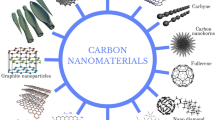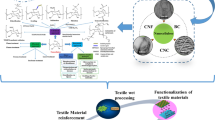Abstract
With the increasing attention of indoor air pollutant, high adsorption performance materials are widely used to deal with formaldehyde. However, the mechanical properties and adsorption efficiency usually limited their applications. In this study, amine-functionalized graphene/fiber composite paper with nacre-inspired structure and high mechanical strength is fabricated through vacuum filtration-induced self-assembly process via a environmentally friendly synthesis route. By the interaction between amine-functional graphene oxide and pine pulp fiber, the formaldehyde adsorption composite paper has been successfully achieved, having high mechanical properties for tensile strength, tear strength and elongation and good adsorption performance. The good physical and adsorption performance of our composite paper provides a new insight into the design and fabrication of advanced photocatalytic materials.







Similar content being viewed by others
References
N. Breslow, C.W. Chan, G. Dhom et al., Latent carcinoma of prostate at autopsy in seven areas. The International Agency for Research on Cancer, Lyons, France. Int. J. Cancer. 20, 680–688 (2010)
K.D.V. Buan, Particulate matter concentrations at children and adult breathing heights in residential thirdhand smoke environments. Dissertations & Theses-Gradworks (2015)
WHO, Environmental health criteria—formaldehyde, vol. 89 (WHO, Geneva, 1989), pp. 1–219
S. Kim, Environment-friendly adhesives for surface bonding of wood-based flooring using natural tannin to reduce formaldehyde and TVOC emission. Bioresour. Technol. 100, 744–748 (2009)
S. Halvarsson, H. Edlund, M. Norgren, Properties of medium density fibreboard (MDF) based on wheat straw and melamine modified urea formaldehyde (UMF) resin. Ind. Crops Prod. 28, 37–46 (2008)
M. Gürü, S. Tekeli, I. Bilici, Manufacturing of urea-formaldehyde-based composite particleboard from almond shell. Mater. Des. 27, 1148–1151 (2006)
J. Liu, Y. Liu, H. Hu, I. Hao, Indoor Air’ 90. In: Proceedings of the Fifth International Conference on Indoor Air Quality and Climate, vol 2 pp 725–730 (1990)
S. Okamoto, Indoor Air’ 90. In: Proceedings of the Fifth International Conference on Indoor Air Quality and Climate, vol 2, Toronto, Canada, pp. 561–564 (1990)
B.P. Leaderer, S.K. Hammond, Evaluation of vapor-phase nicotine and respirable suspended particle mass as markers for environmental tobacco smoke Environ. Sci. Technol. 25(4), 770–777 (1991)
A. Baez, H. Padilla, R. Garcia et al., Carbonyl levels in indoor and outdoor air in Mexico City and Xalapa. Sci. Total Environ. 302, 211–226 (2003)
C. Marchand, B. Buillot, S. Le, Aldehyde measurements in indoor environments in Strasbourg. Environ 40, 1336–1345 (2006)
B. Eriksson, L. Johanssin, I. Svedung, Filtration of formaldehyde contaminated indoor air. In: The Nordest Symposium on Air Pollution Abatement by Filtration and Respiratory Protection, Copenhagen (1980)
H.D. Gesser, The reduction of indoor formaldehyde gas and that emanating from urea formaldehyde foam insulation. Environ. Int. 10, 305–307 (1984)
Y. Sekine, A. Nishimura, Removal of formaldehyde from indoor air by passive type air-cleaning materials. Atmos. Environ. 35, 2001–2007 (2001)
A.C. Balazs, T. Emrick, T.P. Russell, Nanoparticle polymer composites: where two small worlds meet. Science 314, 1107–1110 (2006)
M. Alexandre, P. Dubois, Polymer-layered silicate nanocomposites: preparation, properties and uses of a new class of materials. Sci. Eng. R-Rep 28, 1–63 (2000)
D.Y. Godovsky, Device applications of polymer-nanocomposites. Biopolymers·PVA hydrogels, anionic polymerisation nanocomposites (Springer, New York, 2000), pp. 163–205
P. Li, N.H. Kim, S. Bhadra et al., Electroresponsive property of novel poly (acrylate-acryloyloxyethyl trimethyl ammonium chloride)/clay nanocomposite hydrogels. Adv Mater Res 79, l2263–l2266 (2009). (Trans Tech Pub)
P. Li, N.H. Kim, D. Hui et al., Improved mechanical and swelling behavior of the composite hydrogels prepared by ionic monomer and acid-activated Laponite. Appl. Clay Sci. 46, 414–417 (2009)
S.S. Ray, M. Okamoto, Polymer/layered silicate nanocomposites: a review from preparation to processing. Prog. Polym. Sci. 28(11), 1539–1641 (2003)
Z. Zhiaho, Q. Shi, J. Peng et al., Partial delamination of the organo-montmorillonite with surfactant containing hydroxyl groups in maleated poly (propylene carbonate). Polymer 47, 8548–8555 (2006)
D.D. Evanoff, G. Chumanov, Synthesis and optical properties of silver nanoparticles and arrays. ChemPhysChem 6(7), 1221–1231 (2005)
I.E. Abbott’s, Graphene: exploring carbon flatland. Phys. Today 60, 35 (2007)
Y. Si, E.T. Samulski, Synthesis of water soluble graphene. Nano Lett. 8(6), 1679–1682 (2008)
D.R. Dreyer, S. Park, C.W. Bielawski et al., The chemistry of graphene oxide. Chem. Soc. Rev. 39, 228–240 (2010)
G. Wang, J. Yang, J. Park et al., Facile synthesis and characterization of graphene nanosheets. J. Phys. Chem. C 112, 8192–8195 (2008)
G. Wang, X. Shen, B. Wang et al., Synthesis and characterisation of hydrophilic and organophilic graphene nanosheets. Carbon 47, 1359–1364 (2009)
X. Li, X. Wang, L. Zhang, Chemically derived, ultrasmooth graphene nanoribbon semiconductors. Science 319, 1229–1232 (2008)
P. Blake, P.D. Brimicombe, R.R. Nair, Graphene-based liquid crystal device. Nano Lett. 8, 1704–1708 (2008)
W.S. Hung, C.H. Tsou, M. De Guzman et al., Cross-linking with diamine monomers to prepare composite graphene oxide-framework membranes with varying d-spacing. Chem. Mater. 26, 2983–2990 (2014)
W.S. Hung, Q.F. An, M. De Guzman et al., Pressure-assisted self-assembly technique for fabricating composite membranes consisting of highly ordered selective laminate layers of amphiphilic graphene oxide. Carbon 68, 670–677 (2014)
C.H. Tsou, Q.F. An, S.C. Lo et al., Effect of microstructure of graphene oxide fabricated through different self-assembly techniques on 1-butanol dehydration. J. Membr. Sci. 477, 93–100 (2015)
Y.J. Fu, C.L. Lai, C.C. Hu, Extraordinary transport behavior of gases in isothermally annealed poly (4-methyl-1-pentene) membranes. J. Polym. Sci. Pol. Phys. 54, 2368–2376 (2016)
P.Z. Sun, M.K.L. Zhu, M.L. Wan, Selective ion penetration of graphene oxide membranes. ACS Nano 7, 428–437 (2013)
R.K. Joshi, P. Carbone, F.C. Wang et al., Precise and ultrafast molecular sieving through graphene oxide membranes. Science 343, 752–754 (2014)
J. Liang, Z. Cai, L. Li, Scalable and facile preparation of graphene aerogel for air purification. Rsc Adv. 4, 4843–4847 (2014)
Acknowledgements
The authors wish to sincerely thank the Special Fund for Beijing Common Construction Project and Beijing Forestry University (Grant no. 2016HXKFCLXY001) for financially supporting this work.
Author information
Authors and Affiliations
Corresponding author
Additional information
Publisher's Note
Springer Nature remains neutral with regard to jurisdictional claims in published maps and institutional affiliations.
Rights and permissions
About this article
Cite this article
Zhang, Q., Han, X. & Pu, J. Formaldehyde adsorption composite paper with nacre-inspired structure and high mechanical strength properties. Appl. Phys. A 125, 453 (2019). https://doi.org/10.1007/s00339-019-2723-5
Received:
Accepted:
Published:
DOI: https://doi.org/10.1007/s00339-019-2723-5




